Pond Solutions with EPDM Liners
Mark,... All,.. I've taken the liberty of copying and pasting this thread to a label that I feel is more indicative of the thread ..... new response is at the bottom....... edzard
Posted by: Mark_NoVA 6/7 Snst32 AHS7 (My Page) on Mon, Nov 22, 04 at 10:00
Are there extra concerns when you place the boulders in/around a pond? For instance, using liner, should the pond be filled with water first so the liner won't tear? Should certain tools, such as a tripod, not be place on liner? Should there be a concrete footing under the liner for large boulders? Can rocks be moved/rolled slightly once on the liner, or do they need to be placed exactly in the correct place? Any other concerns/warnings? Thanks.
RE: moving large rocks
Posted by: edzard 3b Canada (My Page) on Mon, Nov 22, 04 at 15:48
what kind of liner?? what is 'large boulder' ? ....... edzard
RE: moving large rocks
Posted by: Mark_NoVA 6/7 Snst32 AHS7 (My Page) on Tue, Nov 23, 04 at 11:00
Ah, yes, sorry, 'large boulder' for me is probably a lot smaller than it is for you. I am concerned about stone anywhere from 0.25 to 1.5 tons. In my personal situation, I am constructing a pond with EPDM rubber liner that will hold around 8000-9000 gallons, along with a 30-foot stream. I will have several strong young men moving stones that I will purchase and have delivered on pallets from a local stone yard. I much prefer larger stones, and am trying to determine what the largest size boulders are that I can safely move and place in this situation, what techniques/tools to use, and how to create safe support for them. I recently bought the Mighty Cart referred to above. I will need to move the stones about 100 feet over a slight downhill slope and safely position them on the EPDM liner. Thanks very much!
RE: moving large rocks
Posted by: edzard 3b Canada (My Page) on Tue, Nov 23, 04 at 16:33
Mark.. is it too late to change the liner to a weldable HD? ...edzard
RE: moving large rocks
Posted by: Mark_NoVA 6/7 Snst32 AHS7 (My Page) on Tue, Nov 23, 04 at 17:14
Yes, I jumped the gun a little bit on buying the liner.
RE: moving large rocks
Posted by: edzard 3b Canada (My Page) on Tue, Nov 23, 04 at 20:50
hmmmm,.. ok.
problems:
when impacted the EPDM "stars', which eventually causes a leak that will break the liner. ANY installers must first agree that if any, any, any impact occurs, there is no embarrassment, none, just that you need to know. Check for a whitish mark.. that is the star. Repair with patch. Take no chances, whatsoever.
-It should be installed after compacting the subbase with a compactor using sand as the slidable material instead of gravel.
Be absolutely certain that there are no stones, rocks in the base that will rise over time. Since temperature changes are not extreme there should be little movement of any rock.
- do spray water on the sand after tamping, and tamp again.
add 1" of sand all around. Where large boulders fit into pre-excavated cavities place carpet under the liner, more sand, and then the liner with carpet on top, then 1" or to grade to fit of sand - course btw.
(the pre work is a large bowl shape? and has shelves or ? What about the stream?)
No tripods. Counter-balanced rotating tripod with a long/short boom may be used on the edge where machinery can not enter.
Fit stone exactly into place by strapping which will come out from the sand. No wire slings.
Place 1/4 inch plywood 'rounds' on edges under each side, so that there is no stretching of the fabric. Stone is set or is rolled off the plywood, final fitting is done with a strap and boom/people lifting juggling. Sand is the medium that supports the stone.
The pond would be lined with small gabian stone NO SHARP EDGES ALLOWED, if stone has a break or edge then ensure that these stones are used soft curved side down, sharp edges up.
or use flat stone disks that are mixed with sand... over the layer of sand, then stone side to side, (patterns may be achieved), and at the edges, they are installed at the same angle as the bottom ground with a slight inward tilt at the heel (toe is out, heel is into the side). This wedging effect will suport the large stones that fit into the cavities. This method displaces the weight over a larger area than just that immediate spot where the stone rests. Try to ensure that these pieces look like a rhombus so that you have almost a castle wall effect showing on the sides. Stones may then be fitted to overhang in the water so that fish may swim under (simialr to a deadman.)
Sweep sand over the entire, this will be a cleaning layer, that will slide down the stones, will hold plants, acts as a natural filter in the movement of the water. This layer will be replaced from time to time, 7- 10 years it gets thinner.. or is scooped out when cleaning the bottom.
No free running water, except in the installation process, mist so that the sand enters the crevices of the stone and settles. The more compact this layer is the longer the liner will last and the more weight it will displace.
Now you could probably use a tripod with foamed load distributors,.. but the work is already done... but you could use a tripod ladder if needed.
all this means that the size of the pond in depth and widths will need to be 12" deeper and 24" wider than planned for a natural surface to show.
where abouts are you located?
jpegs needed?
there is/are other ways of doing this and more I would add, but do not know what stage you are at.. ie: using concrete to float sharp edged stones,.. and this should be a separate thread... (apology to others)
feel free to ask offline, just that replies may not be immediate..
edzard
RE: moving large rocks
Posted by: Mark_NoVA 6/7 Snst32 AHS7 (My Page) on Wed, Nov 24, 04 at 22:58
Edzard, thanks for your well-thought out comments and the time you have spent. I live near Washington DC. The pond has fairly steep sides, with no shelves. This was on advice from some koi people: steep sides and no shelves due to predators. The koi folks (for garden-sized ponds) currently appear to not like stones on the bottoms or sides of ponds, due to increased maintenance as well as the koi injuring themselves on the stone. (Some water garden folks prefer shelves and rocks, though; what do the Japanese gardeners think?) I do plan, however, to have a small area dedicated to water plants separated from the main pond by a rock-topped ridge, with water able to move through the rock cracks. To make up for no stone on the sides, I would like to have the border stones placed several inches or more down in the water with a lip, to help hide the liner below. I really appreciate your comments on how to spread the weight of the large stones, and place them. They will be very helpful. If it is convenient for you to post or email jpegs related to this, I would be happy to see them (but please don't spend too much time on it!). Thanks again!
______ Mark,..
koi people must have some pretty inbred koi that they hurt themselves on rounded stone and sand. That or the koi are protesting some outrage for the unnatural living conditions. What would you do in a concrete box of alkalinity?
-I have no idea why they say that, I've never encountered that thought. More maintenance??? What do they use?? pool vacuums?
What you will have to accept is that you have an EPDM liner.
This means that you Must & Need to protect it from the UV rays, counter to the anti-UV treatments. These liners, when exposed have a 5 year life. Shorter if anyone shoves a stick in the water or a branch falls or other unknown calamity. Not to mention the ground beneath swelling, roots penetrating because there is not enough pressure to stop them etc.
The liner needs to be lined with something or you may choose to replace it every whenever and at the 5 year mark.
No if's and's or's or buts... it needs to be covered.
What is your design solution for covering it?
The other foolishness is the design thought that the pond excavation should be fitted. On the contrary, the shape should be ideally sloping with a not sharper than 60 degree slope, 45 or 30 is better, since the weight distribution system allows any shape to be built within the pond liner by merely adding stone and sand to shape the desired formation. Just that people are lazy.
The stone distribution system, along with protection and design opportunity, with the sand allows various underlaid pipes to be laid for cleaning and filtering the pond, aeration pipes, grated outflows from the bottom water by external vacuum pump. Think in terms of the wall of the house housing the stacks and venting systems. Where to put in an unlined pond??
How would this be accomplished?
the final stupidity (and its not often I call people names, yet animal cruelty warrants it) is that the heat when in sunlight generated from these exposed liners superheats the water allowing the fish to be basted while swimming.
In addition, without ie: one foot down in the water shelves to hide under, the fish have no protection from whatever predators,.. after all herons dive, fishhawks etc. etc. yes you want depth, sharp drops, but they are difficult to engineer with water floating a cobblestones mass held only by sand and gravity... there needs to be a counterbalance space for the overhangs.
and, I suppose I understand your question now about filling first with water, how will you keep the liner from floating from the trapped air??? How will you keep the folds from being sharply stretched & edged excepting to place some sand inbetween to soften the stretch... something still needs to be there to provide these solutions.
...hopefully the book derived flat-shelfed, designed for predator comfort stadium seating ringing around dark stone for extra heat to sooth those little feet on cold nights while fishing for dinner,...
is not the pond edging you'll be using, rather going into stone setting that provides the solution for the highs and lows of the pond.
Koi are jumpers, any deep water on the sides close to the edges within 2.5feet and they'll land out of the water, instead of in the water... not to mention that they enjoy jumping in currents, which are guided to be in the middle of the pond by the vertically set stonework that they swim around to save their sanity.
--- perhaps it makes sense,.. treat them like food in a box and they will be food.
makes me wonder what koi people are suggesting these days..... sheesh,.. a separate area for plants?? What do koi eat? processed koi-food while they try to scrape the algae off on the stone?? of course they will hurt themselves when they have ick etc.
anyway, amazed exclamatory grumbling aside, if anyone has a different design solution, I'm certainly listening. Koi people???
George?... do koi people really engage in this artificial qwatsch?
............edzard

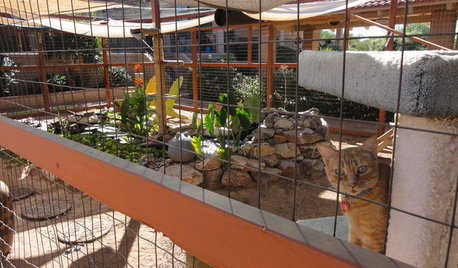
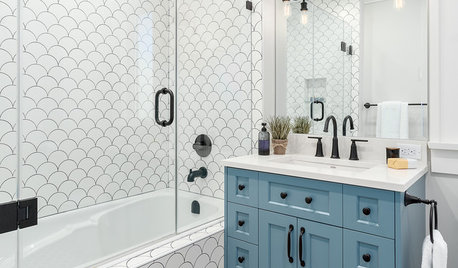
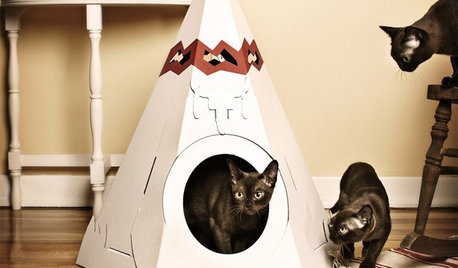


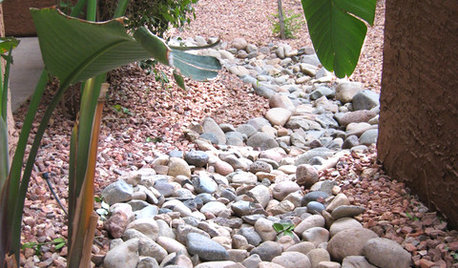
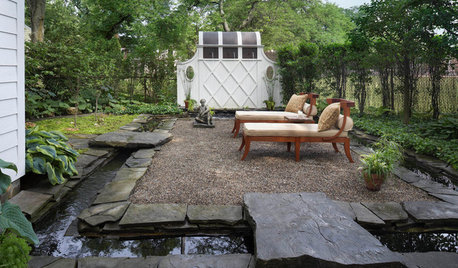
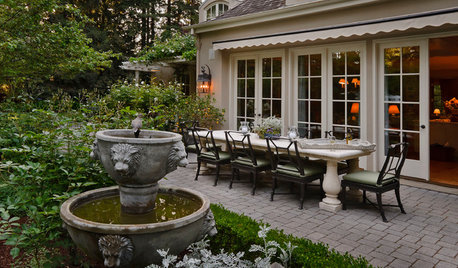




george_in_the_uk
LouisWilliam
Related Discussions
Will turtles rip my epdm pond liner?
Q
Will turtles tear my epdm pond liner?
Q
EPDM Liner over stacked concrete bags
Q
Anyone know where I can locate some EPDM pond liner near Catskill
Q
bluebamboo
edzardOriginal Author
LouisWilliam
edzardOriginal Author
bluebamboo
george_in_the_uk
LouisWilliam